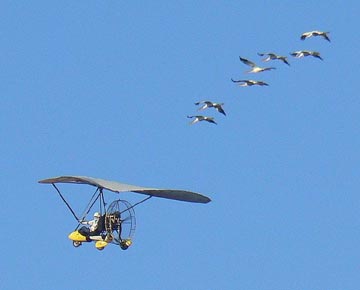The migration of a group of whooping cranes from their summer breeding grounds in Wisconsin to their winter hangout in Florida is unlike any other. The youngest members of the flock are led southward not by their elders, but by an ultralight aircraft. That’s because the birds have never seen the winter habitat before -- they’ve been raised in captivity and transplanted to the wild.
 Whoopoing cranes following an ultralight aircraft. Credit: Wikipedia.
Whoopoing cranes following an ultralight aircraft. Credit: Wikipedia.The birds are one of the great conservation successes of the last half-century. Although whooping cranes once roamed North America by the thousands, by 1941 the population was down to just 16 individuals. All of those were members of a single group, which winters in Texas. But they were declared an endangered species, and thanks to legal protections and the efforts of scientists and volunteers, the population began to rebound. Today, the number of cranes in that group is nearing 300.
Yet there’s always the threat that disease, a hurricane, or an oil spill could wipe them out. So scientists are trying to establish groups in other locations. In 1975, they started transplanting whooping crane eggs to a colony of sandhill cranes in the western U.S., but that effort failed.
So beginning in 2001, they took chicks hatched in captivity to Wisconsin. The birds learned to fly by following the ultralight aircraft, which led them to winter grounds in Florida. In spring, they headed back to Wisconsin on their own. So far, the program is working. By the middle of 2011, the colony had more than a hundred birds -- and one ultralight.

